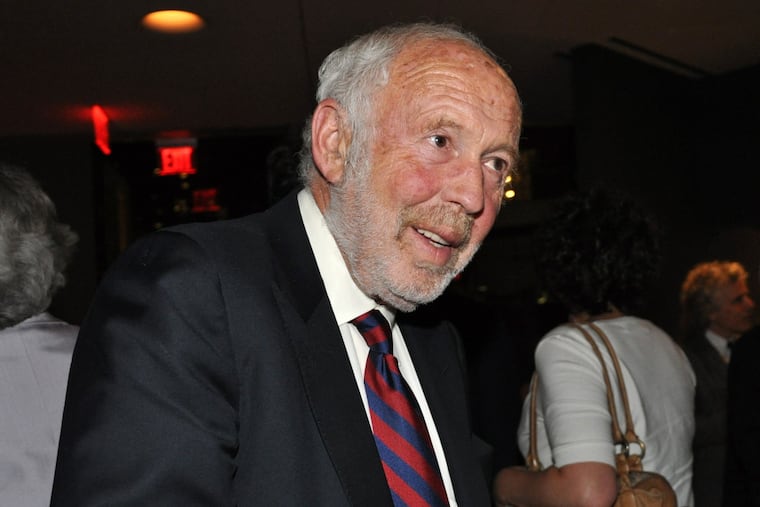How Renaissance Technologies’ hedge fund founder became the godfather of quant trading
Market nerds! Gift this new Wall Street book about the godfather of quantitative trading for the holidays.

If you’re looking for a holiday gift business book, consider The Man Who Solved the Market, a thrilling new tome revealing how Wall Street billionaire Jim Simons created a quantitative computer trading model that literally minted money.
Simons, a former U.S. government code breaker, first made a career in academia as a brilliant mathematician before switching to finance. He cofounded the firm that ultimately became Renaissance Technologies, joining forces along the way with computer science experts, physicists, engineers, and traders, including Trump booster Robert Mercer and Philadelphia activist David Magerman.
Wall Street Journal reporter Greg Zuckerman earned unprecedented access to Simons over the years, and the assiduously private professor-turned-profiteer allowed the author insights into his beginnings in a strip mall and rise to a $50-billion-plus “black box” hedge fund.
The Man Who Solved the Market reveals how Simons and many partners built from scratch computer programs that tracked short- and long-term trends in stock and bond markets, sometimes as short as a few hours. Renaissance predated the popularity of quant trading and artificial intelligence (AI) that today dominates the markets.
Renaissance didn’t always make money, and Zuckerman’s book outlines the fund’s losses and failures as well. And yet Simons, 80, today ranks as one of the world’s richest people, worth $16.6 billion, according to the Bloomberg Billionaires Index. In 1988, Simons started the Medallion Fund, which through last year generated an unrivaled annual average return of about 40%.
Hedge fund managers have emerged as America’s new robber barons, and the book lays plain how these men — and they are mostly men — turned billions of dollars in fees from investors into influence in politics. Those include Wall Street and Silicon Valley billionaires Ray Dalio and GOP donor Peter Thiel, along with Democratic presidential candidates Michael Bloomberg and Tom Steyer.
Simons leaned left, but his partner Mercer over the years put his fortune toward the purchase of Breitbart News and funded the infamous firm Cambridge Analytica, along with President Donald Trump’s campaign for the White House.
Meanwhile, Magerman, of Lower Merion, helped run the quant fund’s research department and was ultimately fired for opposing Mercer’s political views.
If you’re a markets nerd — yup, count me in — you won’t be able to put down this tale of Wall Street converting fitfully from strict fundamental analysis to the powerful computer age. And get a copy for that special someone who loves an inside view of the One Percent.
Vanguard ETFs stole a march on State Street, iShares
The U.S. market for exchange-traded funds (ETFs) has swelled more than 50-fold to $4.2 trillion in assets, up from $771 million in 2010.
The $3.5 trillion increase came mostly through inflows of new money — $2.4 trillion over the past decade — and the rest from the market’s gains, according to new data from Bloomberg’s Eric Balchunas.
ETFs trade like a stock and represent a low-cost way to track an index like the S&P 500, types of bonds, a sector like oil, and even an investment style like small-cap growth.
Fixed-income ETFs, holders of 10% of bond assets, have climbed almost eight-fold to $806 billion, or 19% of the U.S. market, from $103 billion.
The big winner? Local fund giant Vanguard, which stole market share away from State Street and iShares over the past decade.
State Street’s share of the U.S. ETF market has dwindled to 16% from 25% in the last 10 years, while Vanguard’s share rose to 26% from 15%. IShares slipped to 39% from 45%, while Invesco has stayed at about 5%, mainly through acquisitions.
IShares’ inflows totaled $896 billion over the past decade, with Vanguard’s $748 billion and State Street’s $199 billion.
So what’s next for the ETF market? Actively managed “nontransparent” ETFs.
The Securities and Exchange Commission in November signed off on these new products, with sponsors such as Fidelity, Blue Tractor, and T. Rowe Price. These are essentially ETF wrappers around active funds, but structure will be key, said Toroso Investments’ Dan Weiskopf, a commentator for ETF Think Tank.
“There are subtle differences in how the baskets [of, say, stocks or bonds] provide transparency into the ownership of the ETF,” he said.
The biggest challenge will be platform access and track records.
“Is it the same track record as the mutual fund with some tracking error? How does the platform firm benefit by providing access to their clients? Will they be giving up 12b1 [marketing] fees? Is a firm going to be offering a flagship fund at a lesser fee?” he asked.
“Those firms that control custodial, client, and asset management have the best shot at being successful with the wrapper because ultimately, if the new delivery mechanism, a.k.a. semi-transparent wrapper, delivers a better after-tax and after-fee return, the client’s portfolio is improved.”